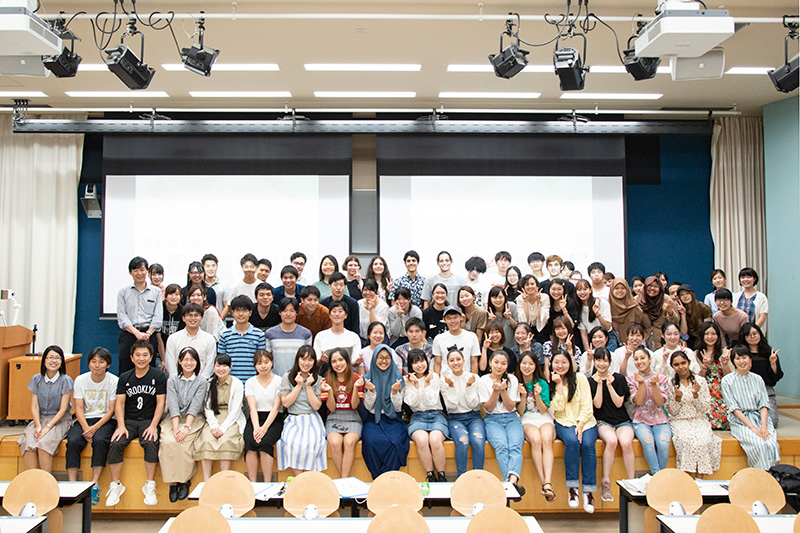School of Japan Studies “Collaboration Project 1” class – Sharing the charms of the towns around TUFS
TUFS Featured
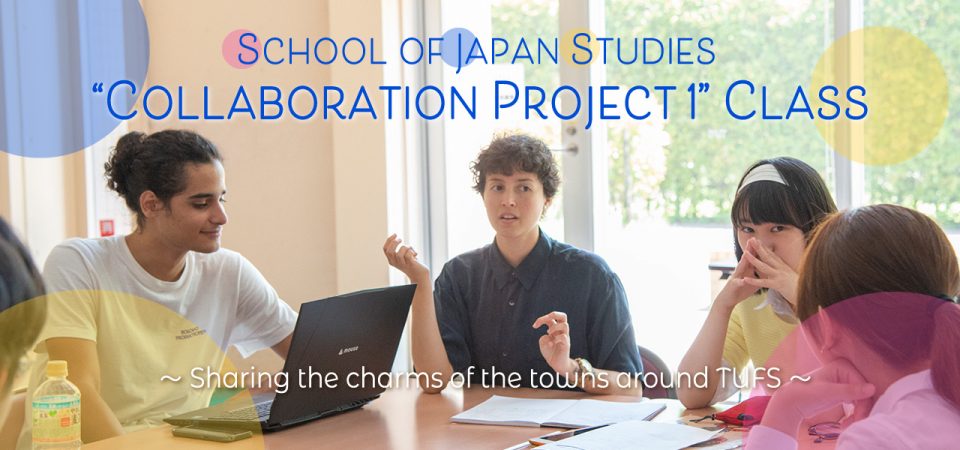
TUFS newly established its third undergraduate program in April 2019 called the “School of Japan Studies.” The “Collaboration Project 1” class is a compulsory class for the 1st year School of Japan Studies students, where students are divided into eight groups consisting of both international and Japanese students. Each group conducted surveys and interviews to capture the charms of the area and compiled the findings into a short program (video clip).
The short programs are now released on the official university YouTube channel “TUFS Channel.”
Before introducing the programs, let us first explain the outline and contents of this “Collaboration Project 1” class.
Advancing the skills for independent thinking, proactiveness, and communication
The short programs that have been released were created as the assignment for the School of Japan Studies 1st year compulsory class “Collaboration Project 1.” International and Japanese students initiate and execute a project which leads to solving the challenges the local area faces. Through such activities, students will not only advance their skills for independent thinking, proactiveness, and communication but also nurture their skills to collaborate in tackling the challenges Japan faces in this phase of increasing multiculturalism.
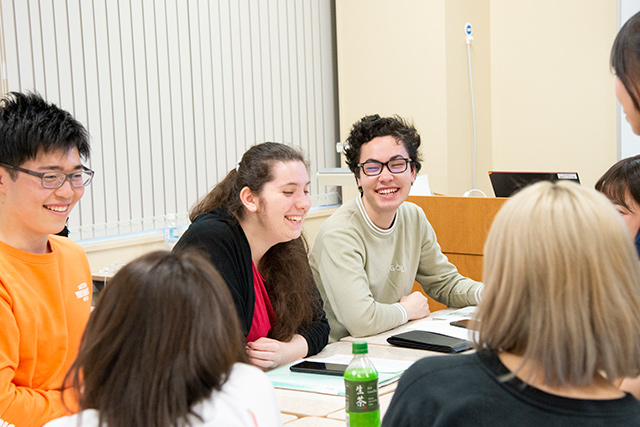
Learning to collaborate
- Group work will be conducted in multicultural teams of students with different mother tongues.
- Students will initiate and execute field surveys as well as interviews with experts on each topic.
- Students will create and present a short program from their findings.
Stepping out of the campus to conduct fieldwork
- Students will choose a topic that relates to Fuchu, Chofu, Mitaka, and the area surrounding TUFS. To gain a deeper understanding of the selected topic, students need to consider where to go, who to meet, and how to research.
- The team will then execute their plans by actually visiting the selected places and conduct interviews with the experts.
- They will then compile and submit the findings at the end of the term as term reports.
Developing skills for communication
- While conducting the fieldwork, students also need to consider what type of program will captivate the interest of its intended audience by illustrating the charms of places, people, and local events.
- To create an attractive program, students need to consider (1) the types of companies that would make appropriate sponsors, (2) the program contents, and (3) the best way to shoot the program. These contents will be summarized into a proposal presented to the expert panel to receive their feedback.
- Students will shoot and edit the program in Japanese and English to make a short TV program.
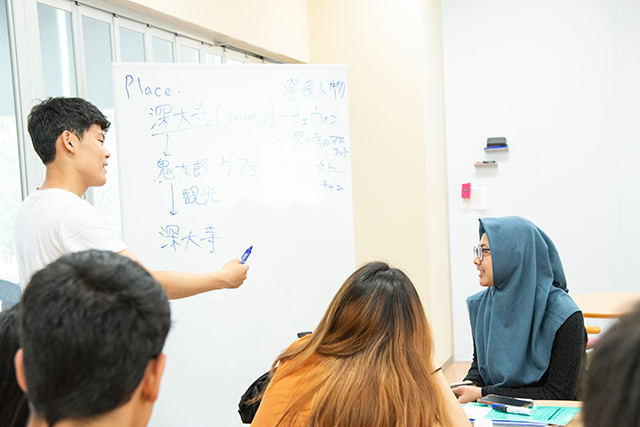
Accumulation of many little intercultural experiences
The 1st year School of Japan Studies is made up of 82 students. There is quite a high percentage of international students with 49 Japanese students and 33 international. Some international students do not have high Japanese proficiency yet, and some Japanese students are not confident in their English.
Their areas of origin also vary; Slovakia, Australia, South Korea, Norway, Mongolia, Singapore, Indonesia, USA, China, Malaysia, Sri Lanka, Taiwan, Thailand, and Japan (in random order).
Students from various cultural backgrounds forming a team to tackle one assignment together. The accumulation of their little intercultural experiences throughout the process has brought these short programs to completion.
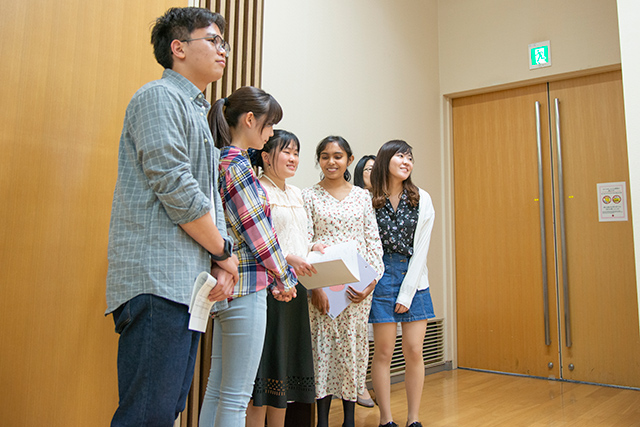
Introducing the short programs!
So, here there are!
(The Group 5 program will be released later)
On the day of the presentation, Mr. Eko Matsui and Mr. Akira Osada of TV Asahi Corporation kindly joined us to evaluate each program on its expected audience rate and satisfaction level of the sponsor.
We shall start with the top 3, followed by the group order.
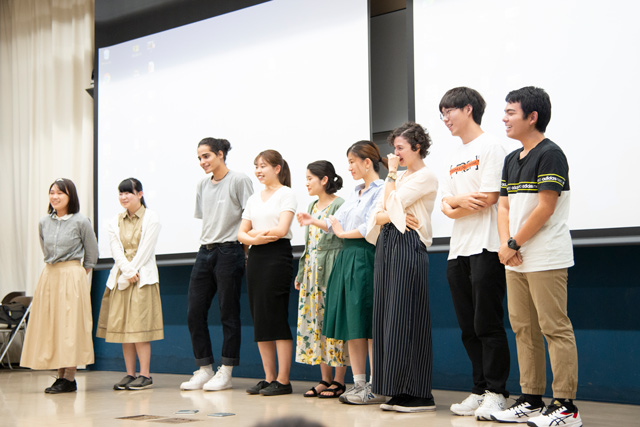
The “History” group won the highest score. The “History” group produced a love-story with Seibu Railway as the assumed sponsor. The team consisted of students from Ecuador, South Korea, Brazil, and Japan. The program is based on the fieldwork conducted at The Center of the Tokyo Raids and War Damage and Fuchu Furusato History Museum and filmed at Chofu Airport, Shiraitodai Station on Seibu Railway, Osawa-no-sato Watermill, Shiraitodai Bunker, Edo-Tokyo Open Air Architectural Museum, and Musashino-no-mori Park.
First Place: Group 6 History
Title: 「花、水迎ふ - Search Through Time –」
Assumed sponsor: Seibu Railway
- Filmed at: Chofu Airport, Shiraitodai Station of Seibu Railway, Osawa-no-sato Watermill, Shiraitodai Bunker, Edo-Tokyo Open Air Architectural Museum, Musashino-no-mori Park.
- Fieldwork and interviews: The Center of the Tokyo Raids and War Damage, Fuchu Furusato History Museum, Teacher (Mr. Morihiko Ushida) of Hosei University Junior and Senior High School
- Students’ area of origin: Ecuador, South Korea, Brazil, Japan
Second Place: Group 8 Agriculture
Title: 「ベジ探偵みやび」 Veggie Detective MIYABI
Assumed sponsor: Yamazaki Baking Co., Ltd.
- Filmed at: Farms at Yotsuya, Honjyuku-cho, and Wakamatsu-cho of Fuchu-shi.
- Fieldwork: 3 farms in Fuch-shi
- Students’ area of origin: South Korea, USA, Taiwan, Japan
Third Place: Group 7 Regional Development
Title: 「調布市ぎ(超ふしぎ)なペギーの冒険」
Assumed sponsor: Kitaro-chaya
- Filmed at: Jindaiji Temple, Kitaro-Chaya, Aoki-ya
- Fieldwork: Aoki-ya, Chofu City Office Public Affairs Service and Sports Dept., Industries Promotion Section.
- Students’ area of origin: Hungary, Brazil, Thailand, Indonesia, South Korea, Japan
Group 1: Traditional Culture
Title: 「神様からの贈り物」A Gift from the Gods
Assumed sponsor: Hirai Ishoten
- Filmed at: Okunitama Shrine, TUFS campus
- Fieldwork: Okunitama shrine
- Students’ area of origin: Slovakia, Australia, South Korea, Norway, Japan
Group 2: Art
Title: 「まひろチャンネルin 府中」Mahiro’s Channel in Fuchu
Assumed sponsor: Idemitsu Kosan Co., Ltd.
- Filmed at: Fuchu-no-mori Art Theater, Fuchu Art Museum, Artist-run-space Café Merdre, Fuchu-no-mori Park
- Fieldwork: Fuchu Art Museum, Owner of Café Merdre
- Students’ area of origin: Mongolia, South Korea, Singapore, Japan
Group 3: Tourism
Title: 「Let’s go 競馬場」 Let’s go to Race Course
Assumed sponsor: Instagram
- Filmed at: Tokyo Racecourse
- Fieldwork: JRA Tokyo Racecourse
- Students’ area of origin: Indonesia, USA, China, South Korea, Japan
Group 4:Sports
Title:「We still don’t know the town we’ve lived in」
Assumed sponsor: Keio Corporation
- Filmed at: Musashino-no-mori Park, Ajinomoto Stadium, Sports & Live Café Choito
- Fieldwork: Fuchu City Policy General Affairs Dept., Policy General Affairs Division, Sports & Live Café choito, Chofu City Office Public Affairs Service and Sports Dept., Industries Promotion Section
- Students’ area of origin: Malaysia, Sri Lanka, Taiwan, South Korea, Japan
Group 5:Industry
Title:「覗いてみよう調布の魅力」 Checkout the charms of Chofu
Assumed sponsor: Canon Inc.
- Filmed at: Ajinomoto Stadium, Mushino-no-mori Sports Plaza, Izakaya restaurant Uoine, Atsuatsu Tetsunage Gyoza-ya
- Fieldwork: Chofu City Office Public Affairs Service and Sports Dept., Industries Promotion Section
- Students’ area of origin: South Korea, Australia, China, Thailand, Japan
Acknowledgment
Our cordial thanks for all the support and cooperation of the many people and organizations who made this project possible.
